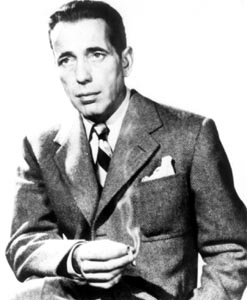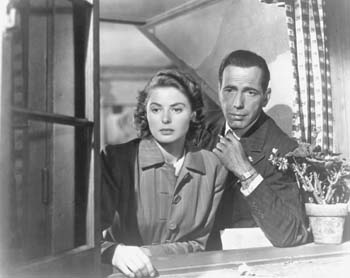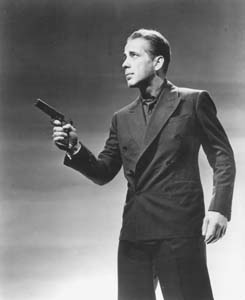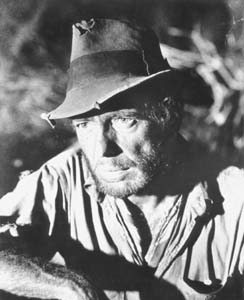
Tough-guy Humphrey Bogart knew that sometimes winning wasn't everything
THE MOST COMMON way for a producer to turn down a project is to say, "The movies are supposed to be about winners, and your lead character looks like a loser." So where does one especially beloved movie star fit into this picture? He was dog-faced, balding, often unshaven. His typical costume was a wrinkled trench coat, rarely belted, always tied, making it look all the more like a bathrobe. His face reflected the knowledge, as studio mogul Louis B. Mayer once put it, that in this world you had to take the bitter with the sour.
In 1993, Entertainment Weekly selected this "loser" as "the greatest movie legend of all time." Humphrey Bogart survives as a star because he uniquely encompasses that opposition between winner and loser in a way that movie producers can't comprehend but that audiences know in their gut.
Humphrey Bogart's most famous film, Casablanca, is loved precisely because his character, Rick Blaine, doesn't take all--in fact, all he has at the end is his honor. Most of Bogart's films aren't triumphs of the American hero over daunting odds; sometimes, they're tie scores and even defeats.
The typical Bogart part is diminuendo: he dies 22 times in his 75 films. Bogart's final tragedy, the cancer of the esophagus that killed him, in 1957, sealed his legend--he maintained the mask of fearlessness as long as he could. If one wants to be a Cary Grant for courtship, a Groucho Marx for wit--one wants to be a Bogart in the face of loss, disease and death. Kenneth Tynan wrote of Bogart onscreen, "He would die with a shrug ...no hard feelings."
In a medium addicted to youth, beauty and glamour, Humphrey Bogart was homely, contemptuous of gloss and middle-aged: 41 when he made The Maltese Falcon, 54 when he spent his last year on the list of Top 10 box-office draws. His legend has been building since shortly after his death, when theaters first started reviving Bogart films for young rebels (who warned each other not to "Bogart that joint"--namely, hoard a reefer as tightly as Bogie clutched his cig).
Even now that yesterday's young furies are today's old burghers, Casablanca is a hit at the Stanford Theater in Palo Alto, bringing them out by the hundreds to see a movie they've seen a hundred times. Bogart has never gone out of style, but this year--the 40th anniversary of his death--has witnessed a resurgence of interest in the actor. Two new biographies have been published, one by Bay Area author Jeffrey Meyers. In July, Bogart appeared on a postage stamp. Starting Friday (Nov. 14), the Stanford Theater presents the most extensive retrospective of his films in the last 20 years anywhere: 44 films in three months (see page 22 for complete schedule).
A novelization of Casablanca by author Michael Walsh will soon hit the shelves, along with the usual depressing rumors of a remake, this time to star Sean Penn. But who needs more proof than this? Mention Bogie to a film fan, and he'll make a soulful face as if he'd just got his guts kicked out in the rain.
![[line]](/gifs/line.gif)
The Stanford Theater's Bogart retrospective.
![[line]](/gifs/line.gif)
Tennis to Rackets
LIKE MANY other American everymen, Bogart sprang from the upper classes. Born in 1899, he was the gently reared, ne'er-do-well son of an upper-class Manhattan doctor and a famed illustrator. The transformation of the patrician Bogart into the late-show "Bogie" was a long process. On stage during the 1920s, and in his early movies, Bogart was, in actress Louise Brooks' words, "still a Humphrey," a tennis-racket-wielder, a cake-eater.
Bogart's first widely noticed film work was as the killer Duke Mantee in The Petrified Forest, in 1936. It was a decisive part that led him to trade in tennis rackets for criminal rackets. He spent the next five years making frequently unimportant films--29 movies in all between 1936 and 1941.
During the 1930s, Bogart played cowboys, crusading journalists and South Seas adventurers, but he was at his best playing smooth criminals. He was capable of staring anyone down, leaning his slightly oversized head, made bigger by expensive fedoras, into other people's faces. But Bogart was only one of the five tough guys on the lot at Warner Bros., and since he wasn't as deft as James Cagney, as Italian as George Raft, or as coarse as Edward G. Robinson, he tended to get the leavings.
It wasn't until High Sierra, in 1941, that the parts improved. Raft had turned down High Sierra because he didn't believe in the unhappy ending; but the role of good bad guy Roy Earle, grizzled and balding, chased into the rocks to die, made Bogart the most fatalistic of movie antiheroes from then until his death.
The larger-than-life Bogie who grew out of the seminal Casablanca, in 1942, sometimes obscures Bogart's range as an actor, which is on full display in the Stanford retrospective. Study, for instance, the variations in these nocturnal roles: the rage-ball screenwriter Dixon Steele (In a Lonely Place), the psychotic Captain Queeg (The Caine Mutiny), the scruffy drifter Fred C. Dobbs (The Treasure of the Sierra Madre). Consider how he embodies sex and suavity in his two films for director Howard Hawks: The Big Sleep and To Have and Have Not. The contrast between prewar and postwar America can be seen in the difference between the somewhat finicking Sam Spade--an art-deco detective--and the rougher, more rumpled Philip Marlowe in The Big Sleep.
"I try to make a case that Bogart is a good actor," biographer Meyers says. "He did have very good training on stage, which most film actors today don't have. They came out of acting school or television, instead. It's hard for me to understand the difference between Mel Gibson and Richard Gere. I suppose it's the kind of movies they're in that supposedly makes them big."
Citing one example, Meyers observes, "Harrison Ford always plays these invincible characters. With Bogart, it's a character that develops from film to film. I suppose it's the Hemingwayish quality of being tough and vulnerable that appeals. He's vulnerable to women--rejecting Bacall [in The Big Sleep] at first, and then succumbing to her."
Bogart's vulnerability extends to ideas as well. "In To Have and Have Not, Bogart says, 'I'm just looking out for myself,' but then eventually he's won over by the Free French Cause," Meyers explains. "Even though Bogart is a man of action, he's reflective, which suggests the kind of change his characters go through. He's clever and he's quick and he's witty. He's not tough in that small-minded way, like Rambo or John Wayne."
Rambo, of course, never loses the final battle, which is why modern movie heroes don't engage our real sympathies. In Bogart's films, however, the fight doesn't go his way every time, and the sacrifices he must offer up make the game interesting.
The more idealistic the age, the more popular Bogart is. In the 1960s, he was a pop hero, postered wherever young people gathered. His suspicious attitude toward authority, his readiness to draw a gun when talking wouldn't work, inflamed student rebels who longed for just such complex toughness.
Understanding Bogart's symbolic value means remembering something about the way movies were received in the 1960s. Movies themselves were unquestionably more magical in those days because of their scarcity. Fans couldn't pick and choose at the video store; if they adored a movie, they had to wait until some theater booked it, even if only for a few days.
Without the evidence to play and replay, what you actually saw on screen was more subjective--it was easier to read in meanings and leap to conclusions. Because of the VCR, the Internet and ancillary merchandising for every film no matter how dreadful, it's hard to understand in 1997 how a figure like Bogart could have been taken into the hearts and minds of '60s radicals and adopted for their own use.
Yet the slow, creaking stirrings of idealism in America after the excesses of the '80s may rekindle Bogart's status as an icon. Who else could make conscientiousness attractive, not just mealy-mouthed? Bogart was often described as a Victorian living in our century. Maybe Edwardian is the better word: conscious of man's duty to tame the world, but ever so slightly ironic about that duty.

We'll Always Have Paris: Bogart and Ingrid Bergman in 'Casablanca,' the film that defined for the first time 'Bogie,' the vulnerable cynic with ideals who knew how to take the bitter with the sour.
The Star Also Rises
THROUGHOUT HIS CAREER, Bogart made the usual missteps of the prolific. Many of even his most notable films bear the marks of haste: the clinking bits of dialogue in Casablanca, and the great strokes of Hollywood providence that rescue Bogart and Katharine Hepburn in The African Queen.
Still, as Meyers comments, "I know that even in his poor movies, there's an interest that he stirs up as soon as he's on camera. Even though he was of average height and weight, he manages to convey this kind of conviction. He was perfect for those Warner Bros. films, with their quick dialogue. The way he delivered his lines, he just fit in perfectly."
In his lesser films, Bogart succumbs to a groping, occasionally boozy, sentimentality, a gratuitous rigidness, a fake contest between duty and desire. Producer Stanley Kramer said of Bogart that "underneath it all, he was a big, sloppy bowl of mush." Sometimes it isn't necessary to drill very far beneath the bedrock to hit farina.
As Meyers notes, Bogart was the Hemingway hero personified. When Bogart's material was weak, his restraint seems forced, as it does in the worst of Hemingway. The act appears ingenuine; his moral code seems occasionally old-fashioned in the worst sense of the world. It is possible to love Casablanca while completely rejecting its argument that a woman ought to stick with a bad marriage just for the sake of the political struggle.
When the material is good, however, Bogart took Hemingway to a new level. What man in the world hasn't wanted Bogart's self-assuredness, his unmatchable coolness? As early as 1941, critic Otis Ferguson had fingered the essence of Bogie: "That authority and decision and hard level talk of his." Men will always be bewitched by adolescent fantasies of aloofness, and the show of heartlessness to disguise the deepness of feeling.
Bogart's offscreen personality could be as tough as his onscreen style. "After he has a few drinks, he thinks he's Bogart" was a joke attributed to a few of his drinking buddies. Lauren Bacall once commented about the stresses of their marriage, "He gets lost in the characterization." Bogart's surliness was so much of his legend that he even wrote a fan-magazine article titled "Why Hollywood Hates Me."
Bogart was famous for picking on people he considered phonies and snobs. The needling was the way he grumbled against what he considered the unmanly business of acting. The dourness with which he received his success was translated into the skepticism of his onscreen persona.
How much of his famous temper was merely a show of independence? Two moments in The Maltese Falcon hint at the distance between the public and private Bogart: Sam Spade having a silent chuckle at his own display of temper outside the elevator in the Fat Man's apartment building and his sotto voce question to Mary Astor's Brigid O'Shaughnessy, "You're not the sort of person you pretend to be, are you?" (I wonder if anyone ever asked Humphrey Bogart that question in real life.)
 Method Man
Method Man
BOGART WAS BOTH an icon of, and a slave to, the studio system. So it is rarely noted that he was a strong link between two halves of movie history. While he made his name in the age of the studio system, he lasted until the modern era of films driven not by studios but by directors and actors.
In films made with scripts that were being rewritten during shooting (Casablanca, The Big Sleep, Beat the Devil), Bogart anticipated the trend toward a looser, more improvised cinema. He had the old-time movie star's professionalism--the ability to hit an emotional mark on command--but he learned his parts internally, almost always refusing to discuss the process.
He thought of himself as Bogie onstage and off--not unlike a modern actor who likes to be addressed by the name of his character even when the cameras aren't rolling. Once, talking about his craft to some young Method actors, Bogart said that he was bewildered by the language and exercises of the Stanislavsky acting method. And then, according to Howard Greenberger's 1978 biography of Lauren Bacall, Bogart continued, "If a guy points a gun at you, the audience knows you're afraid. You don't have to make faces. You just have to believe that you are the person you're playing, and what is happening is happening to you." Which is the point of the Method.
Bogart's posthumous appearance as Jean-Paul Belmondo's idol in Breathless connects the unusual hero with the French New Wave, which would give energy to the movies during the time when Hollywood was in its worst creative slump.

Loser Take All: Bogart excelled as a scruffy drifter in 'The Treasure of the Sierra Madre.'
Casablanca Patient
'CASABLANCA' remains the prime example of how a studio movie could assemble a multitude of different elements--photographers, musicians, script writers, set decorators, costumers, musicians, hordes of character actors--to create a powerful illusion of a remote city. The difference between movies then and now can be found by comparing The English Patient with Casablanca.
The films are reversals of each other, two sides of a coin. Much of the popularity of The English Patient derives from its resonance with Casablanca: the love triangle in the exotic surroundings, the ominous mood of impending war. But in The English Patient, Ralph Fiennes' character collaborates with the Nazis to save his lover. The film has a tragic ending, but it is the baroque, eccentric tragedy of opera that asserts that love is the only law.
In Casablanca, which features perhaps the best-known ending in the movies, Bogart loses the woman he loves in order to help the fight against fascism. In the famous scene of renunciation, as Bogart sends Ingrid Bergman away on the Lisbon plane with Paul Henreid ("The problems of three little people don't amount to a hill of beans in this crazy world"), Bogie makes patriotism appealing to us scoundrels and makes us understand that even the best lose sometimes.
There are a few actors today who don't shy away from loser-friendly endings. Harvey Keitel and Jack Nicholson, when he isn't preening, can carry off Bogart's mood without looking like posers. Still, they are rare. Years before Marlon Brando said he'd rebel against anything you got, Bogart had embodied just that idea. But now, there is no real sense of the noble rebellion that Bogart brought to the movies.
Optimism holds America together. If we lose faith in the happy ending, in the knowledge that tomorrow will be better and that the race is always to the swift, the game is over. The movies, our instructor in how to act and react, are drenched with this optimism. The typical ending of a movie in 1997 is winner-take-everything. A morally suspect career is cleansed by the act of a fatherly boss; the villain is killed not once but three times over; the girl, wavering between money and love, picks love and gets the money too.
Jim Carrey's trademark schoolyard-bully howl of "Loooo-sser!" is key to Hollywood's current vision of coolness. And it is this repellent selfishness, this cult of the winner, that has made the persistence of Bogart, the beautiful, beaten-up loser, all the more precious.
No Quip Needed
As a boy, watching movies with my mother, I remember how she would put her hand over my eyes if there was something she thought I shouldn't see--the scene, for instance, in which Herbert Marshall and Vincent Price discover a strange white-headed fly in a spider web, for example ("Helppp meeee ...").
I recalled the feel of her hand over my eyes while rewatching The African Queen for this article, and I almost missed for a second time one of the scenes that best defines Bogart's essence.
Bogart's Charlie Allnut is dragging the African Queen through a swamp. He gets back on deck to stretch his sore muscles when Katherine Hepburn's Rosey lets out a shriek. Leeches! (Mom was ready. Her hand clapped over my eyes.) He has them on his back and on his arms.
Bogart shudders, mastering his chattering teeth long enough to tell Rosey to go get some salt. Half hysterical, she dusts the parasites with the salt until they fall off him ("filthy little devils"). Bogart's shivering subsides. He takes some ragged breaths and looks around.
They're still aboard a boat stuck in the middle of an African swamp, and there's only one thing Allnut--Bogart--can do. No quip. No comment. Just a wince of smothered pain as he climbs back into the water to feed the leeches.
[ Metro | Metroactive Central | Archives ]
![[Metroactive Movies]](/movies/gifs/movies468.gif)